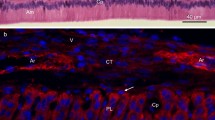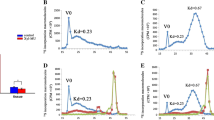Summary
The effect of a proline analog,l-azetidine-2-carboxylic acid (LACA), on protein matrix secretion by odontoblasts and ameloblasts was compared by light and electron microscopic radioautography after injection of3H-glycine in young mice. LACA inhibited the secretion of dentin matrix with consequent accumulation of3H-glycine labeled procollagen in the cisternae of the rough endoplasmic reticulum. In contrast, LACA had no apparent effect on ameloblasts as enamel matrix continued to be packaged in the Golgi apparatus and secreted from Tomes' process within 30 min after injection of the radioprecursor. Electron microscopy revealed that LACA did not cause any change in ameloblast ultrastructure but produced a marked alteration of the odontoblast Golgi complex. All odontoblast Golgi saccules and collagen secretion granules disappeared within 2 h after LACA administration. Odontoblast Golgi cisternae, however, appeared not to be affected. These observations confirm previous studies conducted in this laboratory showing that Golgi saccules in collagen-secreting cells are the initial staging areas for the formation of secretory granules. These results also indicate that a close correlation exists between form and function in the Golgi apparatus of collagen-secreting cells.
Similar content being viewed by others
References
Cho MI, Garant PR (1981) Sequential events in the formation of collagen secretion granules with special reference to the development of segment-long-spacing-like aggregates. Anat Rec 198:309–320
Cho MI, Garant PR (1981) An electron microscopic autoradiographic study of collagen secretion in periodontal ligament fibroblasts of the mouse. I: normal fibroblasts. Anat Rec 201:577–586
Uitto J, Prockop DJ (1974) Incorporation of proline analogues into collagen polypeptides: effects on the production of extracellular procollagen and on the stability of the triplehelical structure of the molecule. Biochem Biophys Acta 336:234–251
Takeuchi T, Prockop DJ (1969) Biosynthesis of abnormal collagens with amino acid analogues. I. Incorporation ofl-azetidine-2-carboxylic acid and cis-4-fluoro-l-proline into procollagen and collagen. Biochem Biophys Acta 175:142–155
Takeuchi T, Rosenbloom J, Prockop DJ (1969) Biosynthesis of abnormal collagen with amino acid analogues. II. Inability of cartilage cells to extrude collagen polypeptides containingl-azetidine-2-carboxylic acid or cis-4-fluoro-l-proline. Biochem Biophys Acta 175:156–164
Rosenbloom J, Prockop DJ (1970) Incorporation of 3-4-dehydroxyproline into protocollagen. Limited hydroxylation of proline and lysine in the same polypeptide. J Biol Chem 245:3361–3368
Uitto J, Hoffman HP, Prockop DJ (1975) Retention of nonhelical procollagen containing cis-hydroxyproline in rough endoplasmic reticulum. Science 190:1202–1204
Lane J, Parkes LJ, Prockop DJ (1971) Effect of the proline analogue azetidine-2-carboxylic acid on collagen synthesis in vivo. II. Morphological and physical properties of collagen containing the analogue. Biochem Biophys Acta 236:528–541
Glimcher MJ, Levine PT (1966) Studies of the proteins, peptides and free amino acids of mature bovine enamel. Biochem J 98:742–753
Mathews MB (1975) Connective tissue: macromolecular structure and evolution. Springer-Verlag, New York
Sjostrand FS (1967) Electron microscopy of cells and tissues. Academic Press, New York, p 161
Reynolds ES (1963) The use of lead citrate at high pH as an electron opaque stain in electron microscopy. J Cell Biol 17:208–213
Garant PR, Cho MI (1979) Autoradiographic evidence of the coordination of the genesis of Sharpey's fiber with new bone formation in the periodontium of the mouse. J Periodont Res 14:107–114
Caro LG, Van Tubergen RP (1962) High resolution autoradiography. I. Methods. J Cell Biol 15:173–188
Slavkin HC, Mino W, Bringas P (1976) The biosynthesis and secretion of precursor enamel protein by ameloblasts as visualized by autoradiography after tryptophan administration. Anat Rec 185:289–312
Warshawsky H, Vugman I (1977) A comparison of the protein synthetic activity of presecretory and secretory ameloblasts in rat incisors. Anat Rec 188:143–172
Warshawsky H (1979) Radioautographic studies on amelogenesis. J Biol Buccole 7:105–126
Carneiro J, Leblond CP (1959) Role of osteoblasts and odontoblasts in secreting the collagen of bone and dentin, as shown by radioautography in mice given tritium-labeled glycine. Exp Cell Res 18:291–300
Young RW, Greulich RC (1963) Distinctive autoradiographic patterns of glycine incorporation in rat enamel and dentin matrices. Arch Oral Biol 8:509–521
Weinstock M, Leblond CP (1974) Synthesis, migration and release of precursor collagen by odontoblasts as visualized by radioautography after3H-proline administration. J Cell Biol 60:92–127
Josephsen K, Warshawsky H (1982) Radioautography of rat incisor dentin as a continuous record of the incorporation of a single dose of3H-labeled proline and tyrosine. Am J Anat 164:45–46
Reith EJ (1967) The early stages of amelogenesis as observed in molar teeth in young rats. J Ultrastruct Res 17:503–526
Garant PR, Nalbandian J (1968) Observations on the ultrastructure of ameloblasts with special reference to the Golgi complex and related components. J Ultrastruct Res 23:427–443
Warshawsky H (1968) The fine structure of secretory ameloblasts in rat incisors. Anat Rec 161:211–230
Jameison JD, Palade G (1967) Intracellular transport of secretory proteins in the pancreatic exocrine cell. I. Role of the peripheral elements of the Golgi apparatus. J Cell Biol 34:577–598
Garant PR, Szabo G, Nalbandian J (1968) The fine structure of the mouse molar odontoblast. Archs Oral Biol 13:857–876
Reith EJ (1968) Collagen formation in developing molar teeth of rats. J Ultrastruct Res 21:383–414
Weinstock M (1972) Collagen formation. Observations on its intracellular packaging and transport. Z. Zellforsch Mikrosk Anat 129:455–470
Gartner LP, Seibel W, Hiatt JL, Provenza DV (1979) A fine-structural analysis of mouse molar odontoblast maturation. Acta Anat 103:16–33
Weinstock A, Leblond CP (1971) Elaboration of the matrix glycoprotein of enamel by the secretory ameloblasts of the rat incisor as revealed by radioautography after galactose-3H injection. J Cell Biol 51:26–37
Tan EML, Ryhanen L, Uitto J (1983) Proline analogues inhibit human skin fibroblast growth and collagen production in culture. J Invest Derm 80:261–267
Weinstock A, Weinstock M, Leblond CP (1972) Autoradiographic detection of3H-fucose incorporation into glycoprotein by odontoblasts and its deposition at the site of the calcification front in dentin. Calcif Tissue Res 8:181–189
Bennett G, Leblond CP (1970) Formation of cell coat material for the whole surface of columnar cells in the rat small intestine as visualized by radioautography withl-fucose-3H. J Cell Biol 46:409–416
Bennett G, Leblond CP (1971) Passage of Fucose-3H label from the Golgi apparatus into dense and multivesicular bodies in the duodenal columnar cells and hepatocytes of the rat. J Cell Biol 51:875–881
Bennett G, Leblond CP, Haddad A (1974) Migration of glycoprotein from the Golgi apparatus to the surface of various cell types as shown by radioautography after labeled fucose injection into rats. J Cell Biol 60:258–284
Bennett G, Leblond CP (1977) Biosynthesis of the glycoproteins present in plasma membrane. Lysosomes and secretory materials as visualized by radioautography. Histochem J 9:393–417
Farquhar MG, Palade GE (1981) The Golgi apparatus (complex)-(1954–1981)-from artifact to center stage. J Cell Biol 91:77s-103s
Author information
Authors and Affiliations
Rights and permissions
About this article
Cite this article
Cho, MI., Garant, P.R. Comparative radioautographic study of the effects of L-azetidine-2-carboxylic acid on matrix secretion and golgi of the mouse incisor. Calcif Tissue Int 36, 409–420 (1984). https://doi.org/10.1007/BF02405353
Issue Date:
DOI: https://doi.org/10.1007/BF02405353




